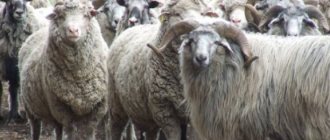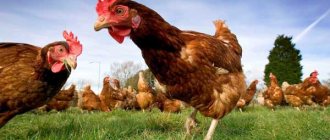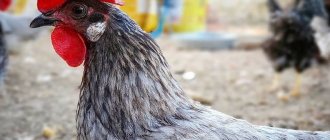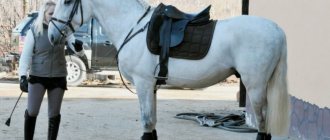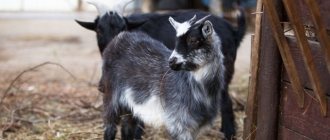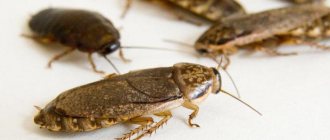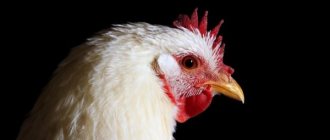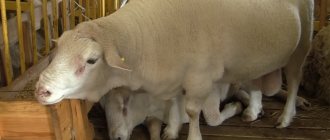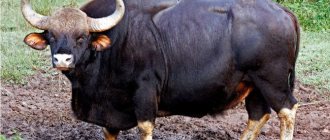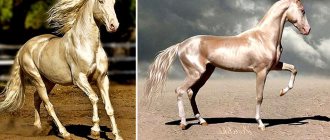Livestock » Sheep
0
1289
Article rating
Kira Stoletova
Sheep of the Precos breed first appeared in France. This breed was named this way for a reason: Precos is translated from French as “precociousness.” Already from this we can conclude that the Prekos sheep breed becomes suitable for reproduction quite early. The Prekos species is raised for meat and wool.
Description of Prekos breed sheep
Content
Precos do not require special care. In warm weather, they are kept on pastures and feed on meadow grass. Under favorable temperature conditions, grazing continues throughout the year. If the winters are harsh, then the animals are kept in stalls (a plank room is enough for them). Sheep breeders are advised to monitor the temperature (not lower than 5 degrees) and avoid drafts so that the growth of the livestock does not decrease. In winter, they eat hay (clover, forbs, cereals and legumes), and mixed feed. They are also advised to give:
- grain crops (oats - up to 2.5 kg per individual);
- wheat bran;
- cakes, vegetables (carrots, fodder beets, cabbage), fruits (apples);
- rapeseed, silage, potato peels;
- vitamin and mineral supplements.
Do not forget about the need for salt, give at least 10 g per day. To increase the quality and productivity of wool, it is recommended to add to the diet (per head):
- sodium sulfate (up to 3 g);
- sodium sulfate (up to 4 g);
- elemental sulfur (1 g).
With little feed consumption, precots gain weight well.
With little feed consumption, they gain weight well.
It is important to provide them with enough food at a young age, when they are rapidly gaining weight (then the rate decreases)
Grass and hay
Main food: in summer - grass in the meadow, in winter - hay.
And given that sheep eat many types of grass (even those that cows do not eat), such food is cheap. In the evening I sprinkle 2-2.5 kg of oats per head - it is good for digestion, but corn and wheat, on the contrary, contribute to upset, so I don’t give them. I feed potato peelings, apples, pears, beets, potatoes, cabbage, pumpkin, carrots. The water in the drinking bowl is always fresh. I definitely give table salt, preferably in the form of a lick, because sheep’s need for it is 10-15 g per day. I don’t add vitamins separately to the food - there are enough of them in the food.
Sheep breeders' advice
Farmers speak positively about the productivity of Prekos sheep and give the following recommendations to novice sheep farmers:
- You should not cross Prekos with other breeds at an early age: the offspring will be weak and unproductive.
- To form a herd, lambs should be purchased at least 2 months old. In this case, it is advisable to choose individuals from among twins: in the future, this guarantees the fertility of the sheep.
- Sheep must be sheared twice a year. The wool will be of higher quality.
- The highest quality and most delicious meat can be obtained by slaughtering young animals at the age of 9 months.
Prekos sheep are a worthy breed for private breeding due to their increased fertility and productivity in meat and wool.
The video shows Prekos sheep at an exhibition.
Popularity of the breed in Russia, Belarus and Ukraine
Breeding Prekos sheep is considered a profitable business.
Breeding Prekos sheep is a profitable business due to the high productivity of the breed in terms of meat and wool, as well as the fertility of the queens. Thanks to these qualities, the breed has gained popularity among sheep farmers in Russia, Belarus and Ukraine.
[adsp-pro-7]
The most favorable climatic conditions for raising sheep at home are in the south of Russia and Ukraine. Most often, sheep of this breed can be found in the Voronezh, Tambov, Kursk, Belgorod regions and Krasnodar Territory. Selection work based on this breed is actively carried out in Ukraine. The result of crossbreeding was the development of new varieties of sheep: the Transcarpathian type and the Kharkov type of prekos.
On the territory of the Russian Federation, the Moskalensky farms are engaged in industrial breeding of prekos sheep.
Description of the breed
Animals of this species are distinguished by their precocity and fairly good, strong physique. The skeleton of prekos is well developed and strong; cattle of this species are fleshy, with well-developed muscles. The legs of the rams are widely spread, and the back is flat and wide. Coat color: white, sand. The head and legs are hairless. Most rams of this breed are polled, only 20% have horns. Animals of this species are considered precocious in all respects - rate of weight gain, onset of puberty, etc. Pregnancy in females is often multiple (twins).
Sheep of this breed are famous not only for their meat productivity, but also for their fairly good wool quality. The structure of the fleece is uniform, the “curls” of average thickness are 1 cm. The length of the coat of males is 9-10 cm, that of queens is 8-9 cm. The average clipping of males is 8-9.5 kg, and that of females is 4-5 kg. The net fiber yield is 48-50%, which is about 2.5-2.6 kg. The fineness of wool ranges from 25.1 to 40 microns, the quality can reach from 44 to 58 units. The fleece has a staple and braided structure.
Since Prekos is an early ripening type, lambs at the age of 4 months, with the right diet and favorable conditions, reach a weight of 28-30 kg. In order to obtain high-quality lamb, animals are slaughtered at the age of 8-9 months; their carcass weight, with proper feeding, is 20.5 kg. The live weight of adult rams ranges from 80 to 100 kg, and that of queens – 58-62 kg. In breeding herds, the record weight of a ram reaches 120 kilograms.
Multiple pregnancy is not uncommon for Precos sheep; such lambing is observed in 30-40 percent of cases. Fertility as a percentage per 100 sheep is 130-140%. Today, breeders continue to work to increase the fertility of Prekos sheep.
Breed overview
Modern breeds were bred from ancient fat-tailed sheep, adopting their best properties from their ancestors. They differ from each other in body constitution, coat quality and other characteristics. Let's take a look at the popular fat-tailed breeds.
Gissarskaya
This breed appeared thanks to the efforts of Tajik and Uzbek rural breeders. They crossed fat tail queens with local rams. The name was given to the new breed in connection with the region where it was bred, and this happened on the Gissar mountain range, which crosses the territory of Uzbekistan and Tajikistan.
Sheep of the Gissar breed have the following external characteristics:
- heavy bones;
- wide chest;
- disproportionately small head;
- humped nose;
- no horns;
- thin and long limbs;
- coarse wool of black, brown or white color;
- height at withers 80-85 cm;
- The average weight of an adult is 80-100 kg.
Since the wool of hissars is not highly valued, and the annual shearing from them is small, it is more profitable to breed these sheep in order to obtain meat, lard and milk. Young animals aged 4-5 months are suitable for slaughter; their meat is tender and juicy, and the slaughter yield at this age reaches a maximum of 60%. These animals are cut in spring and autumn, because in extreme heat the hair creates inconvenience.
Attention! Gissar - the largest breed of fat-tailed sheep
Kalmytskaya
This breed owes its origin to the Mongols. In the 17th century they entered the territory of modern Russia. The sheep they brought with them were crossed with local breeds, resulting in a new variety of fat-tailed sheep, which was called Kalmyk.
One of the advantages of these animals is their ability to adapt to difficult living conditions. They are hardy and unpretentious, like their ancestors, who had to overcome vast distances with nomads.
- high growth;
- the skeleton is massive;
- well developed chest;
- the body is knocked down, voluminous;
- limbs are strong, sinewy, long;
- color white, red or black;
- coarse wool;
- fat tail weight – 17 kg;
- The average weight of a Kalmyk ram reaches 90-110 kg, and that of a sheep – 50-70 kg.
Kalmyk fat-tailed sheep are bred for meat and lard. Their fur is very coarse, so it is rated low. It is suitable for the production of carpets, felted shoes and other warm products.
Edilbaevskaya
About 200 years ago, Kazakh sheep breeders carried out a series of crosses between local fat-tailed sheep and representatives of coarse-wool breeds brought from Astrakhan. The resulting breed absorbed the best qualities of its ancestors - the ability to feed on sparse vegetation, move long distances, and tolerate heat and cold normally.
- the animals are quite tall, the height at the withers reaches 85 cm;
- body length – 80-90 cm;
- chest volume – 90-100 cm;
- ram weight – 100-110 kg, uterus – 60-70 kg;
- color – red, brown or black;
- no horns;
- The wool is coarse and is used in the carpet industry.
The advantage of the Edilbaevskaya breed is its early maturity. Lambs are born weighing no more than 6 kg, but already at four months of age their weight increases to 40 kg, with the fat tail weighing 4 kg. At 4-5 months, the slaughter yield of lamb reaches 60%.
Breeds from neighboring countries
There are breeds from neighboring countries of Russia, which are also considered meat breeds and are common in rural animal husbandry.
Saradzhinskaya
The cattle themselves are white, and the legs and head are red; there are also dark sheep. The cattle are large, the bones are heavy, and the body itself is short. Males have small, rounded, hard horns. Adult males weigh up to 90 kilograms, and females weigh up to 75 kilograms of live weight. The weight of newly born lambs is about 4.5 kilograms; by the age of four months their weight reaches 40 kilograms. Sheep of the Sarajin breed have lard, tender meat and wool, with which professionals make carpets.
Foreign breeds
Foreign breeds of sheep are no less popular. But they also have their own advantages and disadvantages.
Texel
This breed began to be bred back in Roman times, and the Texel breed was completely bred only at the end of the 19th century. The weight that adult males can reach is 130 kilograms; in females it is slightly lower – 125 kilograms. Lambs quickly gain weight and at 5 months can weigh 60 kilograms. Carcasses have a lot of muscle tissue and tender meat, which also cooks quickly. This breed is not fussy about feeding.
Prekos
The Precos, a breed of French origin, is popular and is bred all over the world. Sheep are barrel-shaped, strong, have high immunity, are unpretentious in feeding and bear good fruit. A newborn lamb weighs 5 kilograms, and a four-month-old lamb already weighs 35 kilograms of live weight. An adult male weighs approximately 130 kilograms; when slaughtered, 55 kilograms of meat comes out. Females weigh 65 kilograms at one year of age.
Barbados black-bellied
A short-haired meat breed that originated in the Caribbean. There is also a horned breed bred in America, it was created by crossing with the Ramboulier breed. The size of the sheep is medium, the bones are strong, and their color is dark red. And males have a mane on their chest and neck, hair length is 12-16 cm. The weight of an adult male is up to 90 kilograms, and females up to 60 kilograms. Lambs are born weighing 3 kilograms; by the age of three months they reach 17 kilograms. Females give birth to three lambs in two years, and the females of this breed have a lot of milk, which ensures a daily weight gain of the lamb of about 250 grams.
Wiltshire horned
The hairless breed of Wiltshire sheep was developed in England in 1923, and is currently bred in North Wales. Sheep have no wool; instead, their white skin is covered with stiff, horse-like hair. Rams have strong and well-developed horns. Adult males weigh about 100 kilograms, and females 60 kilograms. Females become good mothers and differ from some breeds in their large amount of milk.
Dorper
This breed appeared in the last century in South Africa, thanks to the crossing of the following breeds:
- Dorset Horn.
- Fat-tailed Persian blackheads.
- Fat-tailed.
The Merino breed was also crossed, which gave the sheep a pure white color. Because South Africa has harsh weather conditions, droppers had to survive in extreme cold and with minimal food. Thanks to this, they have developed excellent immunity, resistance to disease, and they can endure the harshest, coldest and snowiest winters. The same applies to summer; droppers can even live for two days without water in the summer.
The face of this breed is shortened, so the head appears small and cube-shaped. Although their legs are short, they are strong because they can support their own weight. Males can grow up to 140 kilograms, and females up to 95 kilograms. Lambs gain weight quickly and at the age of three months they already weigh 25 kilograms, and by the age of six months their weight is 70 kilograms.
Zwartbles
A century ago in Holland, such a meat breed of sheep was bred as the Zwartbles, whose meat is lean, tender and very tasty. The weight that adult males can reach is 130 kilograms, and females 100 kilograms. Thanks to their thick wool, sheep survive even the coldest and snowiest winters, winds and can graze in moisture. They are also unpretentious in feeding.
Lambs
At birth, babies weigh up to five kilograms. With little feed costs, they quickly gain weight. Already at 4 months, the young weigh about 40 kilograms, and at six months - 55 kg.
Throughout the entire period of the breed’s existence, breeders are constantly working to improve its characteristics. With proper selection, the percentage of fertility increases annually by 2-4%. The main thing in this matter is to follow some rules:
- You should not crossbreed too young individuals, as they produce weak offspring.
- When animals mate, multiple pregnancies produce offspring that are highly fertile.
- When purchasing adult animals, preference should be given to sheep at least two months old.
After birth, the lambs quickly rise to their feet and behave actively. They have a thick coat of fur that becomes even denser as they develop.
Ewes do not have problems with feeding their offspring, since the breed has good milk production. Lambs are weaned when they reach a weight of 30-35 kg.
When breeding Prekos sheep, it is important to provide the young animals with sufficient nutrition, especially in the first months of life, since it is during this period that intensive weight gain occurs, and as they grow older, the growth rate decreases
Romanovskaya, 50-100 kg
In the 18th century, in the Yaroslavl province, the Romanov sheep appeared on peasant farms.
She was one of the most outstanding in terms of fur coat qualities and received this name because... initially spread in the Romanovo-Borisoglebsky district. The queens of this breed are small, weighing up to 55 kg, but some individuals grow up to 90 kg, while the rams are much heavier - from 65 to 75 kg, sometimes they weigh 100 kg. They are kept for the lightest, most elegant and durable sheepskins.
The skin of lambs 6-8 months old is especially valued. Babies of this breed have a black coat, but from the second to fourth week it becomes lighter, and by five months it becomes depigmented.
But, despite the fact that they are bred for sheepskin, they are also valued as sources of meat, because... Already at 100 days, lambs can weigh up to 22 kg, and at 9 months - 40 kg.
Advantages and disadvantages of the breed
Prekos sheep are highly valued not only for their wool, but also for other advantages:
- meek and calm disposition;
- rapid weight gain - daily weight gain of lambs is 250-280 g;
- wool quality;
- fertility of ewes - 150 lambs are produced from 100 females;
- ability to adapt to different conditions and climate.
Prekos sheep, despite many positive qualities, also have disadvantages:
- the net yield of wool after processing is low, it is 50%, and all because not all areas of the animal’s body are covered with it;
- heterogeneity of cutting;
- uneven growth of fibers in different parts of the sheep’s body.
In breeding farms, special attention is paid to the culling of animals. Those individuals that do not meet breed standards are not allowed to mate.
These include lambs that are slow to gain weight, those with body defects, including underdeveloped reproductive organs, and animals with reduced sexual activity.
Advantages of the Texel breed
Texel has been present in Europe for 200 years. Farms regularly take care of the condition of the offspring, selecting the best representatives of the future generation. Crossbreeding often takes place with other breeds. This work leads to positive results that cover the existing shortcomings. The positive aspects include:
- High ratio of high quality meat. The net yield per carcass is 60%
- Soft wool with different colors.
- Sheep quickly adapt to local conditions due to their endurance.
- Stable character and high independence.
- Developed muscles.
Productivity indicators
The indicators of meat and wool breeds are determined by the amount of marketable lamb, the shearing of unwashed wool and the % of washed wool yield. The meat of 8-10 month old lambs has the best taste. With a monthly gain of 4-5 kilograms, they gain weight up to 40-50 kilograms. The maximum shearing per ram is 10 kilograms, per sheep – 5 kilograms.
Wool characteristics:
- staple fleece;
- output of washed wool – 50%;
- hair length – up to 8 centimeters;
- wool fineness – 60/58-64;
- cream fat, 30%;
- tortuosity is normal.
Staple fleece is a coat consisting of tufts of wool, identical in type, length and thickness of hair. The fleece of fine-wooled sheep has a staple structure.
Grease is a secretion of the sebaceous and sweat glands that protects the wool from matting, contamination, and mechanical damage. The maximum percentage of grease is found in fine-wool merino wool (40%). On average, 100 queens give birth to 140-150 lambs annually.
Karakul breed
The Karakul breed of sheep is one of the most ancient meat varieties. It is bred in many European countries, Africa, America and Asia. In addition to delicious meat, sheep have excellent skin. The Karakul sheep appeared thanks to the work of breeders from Uzbekistan. A special feature of this breed of sheep is the presence of a long tail, but the rams do not straighten it, so it hardly reaches the hock joints.
If we talk about the features of the exterior, the karakul is a hump-nosed ram with ears of medium length. The massive body is supported by thin limbs that end in powerful hooves. The head, legs and neck are covered with short hair, colored black. Over time, most fur, regardless of its original color, becomes gray. Livestock breeders characterize the depigmentation process as graying.
The wool of astrakhan sheep can be dyed black or gray. About 10% of sheep have a sur color. About 4% of sheep are white or brown. Sometimes there are individuals with pink fur.
Productivity indicators
In addition to wool, Karakul sheep are valued for their tasty meat. Meat productivity is 65 kg for rams and 45 kg for queens. The weight of a newborn lamb rarely exceeds 4.5 kg. Lambs quickly gain weight, which is an advantage of the breed. Excellent sheep cheeses are prepared from rennet obtained from 1-2-day-old lambs and sheep's milk. Livestock farmers also make money from sheep wool. It is possible to shear about 4 kg of wool from sheep per year. On average, 3 kg of wool is shorn from sheep.
Fertility is another important characteristic for livestock farmers. A flock of 100 ewes produces 140 lambs annually.
Prekos
The Precos breed was also obtained in France. Ramboulier and fine-wooled English sheep were used to breed it. Thanks to their parental genes, the animals inherited a strong constitution, good body hair and early maturity.
- massive body;
- the back is straight, the sacrum is wide;
- legs are placed correctly;
- sheep are polled, lambs are partially horned;
- The weight of the male reaches 120 kg, the uterus - 65-70 kg;
- length of wool fibers – 8-10 cm, yield of raw materials after washing – 48%;
- fineness class – 58-60;
- fertility – 140%.
The disadvantage of the breed is the lack of hair on the abdominal area, head and limbs.
Sheep Prekos
The Precos sheep breed belongs to the category of meat and wool and is a distant relative of the Merino sheep. After its appearance, animals were bred mainly on the territory of Ukraine, and later prekos spread to some regions of Russia. This article will introduce readers to the characteristics and description of Prekos sheep, and tell about their advantages and disadvantages.
Prekos sheep breed
Nutrition
According to the description, keeping the Prekos sheep breed is not difficult. In summer, sheep eat green feed obtained from pastures. This is their main diet in the warm season. In the fall, animals begin to be fed additionally, introducing into the diet:
- Bran.
- Silage.
- Cereals.
- Vegetables, fruits, root vegetables.
- Cake.
Vitamins are included to enhance immunity. Throughout the year, sheep should have free access to mineral supplements in the form of lick salt, fish or bone meal. They are necessary to improve the quality of the coat and appearance.
Sheep must also be provided with constant access to fresh water.
Due to the fact that sheep are unpretentious animals, their maintenance does not require special care or special conditions. Individuals can graze on pasture all year round; only in cold weather they are kept in stalls built of wood. In this case, the air temperature should not be less than 5 ºС. The stalls should be dry and clean.
The presence of drafts in the sheepfold is unacceptable. One animal requires about 2 m² of indoor space. There should be no dampness or excess humidity in the sheepfold. The room should be well ventilated and protected from rodents by metal fences dug into the ground along the perimeter of the sheepfold.
For sheep, mandatory care activities are:
- cleaning, trimming hooves;
- inspection after walking;
- vaccination;
- cleaning and washing drinkers, feeders;
- haircut twice a year;
- Regular examination by a veterinarian.
When switching from a summer to a winter diet, it is necessary to introduce seasonal products gradually. A sudden change in food can lead to gastrointestinal disorders. Do not forget that livestock needs clean drinking water in sufficient quantities.
Diet
The Tsigai breed is very demanding regarding nutritional conditions - the quality and quantity of food. The diet is formed depending on the sex, age and degree of fattening of the animal. In summer, animals eat green grass in pastures. The daily norm for an adult male is about 10 kilograms of grass, for a female – up to 8 kilograms.
Expert opinion
Zarechny Maxim Valerievich
Agronomist with 12 years of experience. Our best country expert.
Ask a Question
It is enough for young individuals to eat about 6 kilograms of food per day. It is advisable to supplement the diet with legumes and grains. Sheep require regular drinking.
In winter, when females bear cubs, nutrition should be complete and varied:
- hay;
- vegetables and root vegetables;
- compound feed;
- mineral supplements.
Wool-meat type lambs
The fine-wool wool-meat breed has greater weight and size than the wool breed. There are no obvious folds on the skin, but the body structure of this type is more powerful.
To date, there are 8 known breeds:
- Askaniyskaya;
- Caucasian;
- Transbaikal;
- Kyrgyz;
- Yuzhnouralskaya;
- North Caucasian.
The fine-fleece sheep of the wool-meat type has a large body with well-developed muscles. This species is also distinguished by a good layer of fat and high-quality meat. Rams gain weight up to 110 kg, and sheep can weigh a maximum of 65 kg.
Fine wool sheep of wool-meat type
A male can produce 15 kg of wool in one year, and a female can produce 6 kg. The length of one hair of this type is 9 cm. Its main advantage is high quality meat. The wool-meat type can most often be found in different regions of Ukraine, because these animals are adapted to a temperate climate.
Productivity
The Prekos sheep breed shows good productivity values in both wool and meat production. The meat of these animals has excellent taste. Young lamb is especially valued; it is obtained from lambs aged 4-5 months. By this time, the animals manage to gain weight of 40 kg. At this age, the slaughter meat yield exceeds 58%.
Prekos sheep are fine-wooled. The average annual clip per ram is 9 kg, per ewe – 5 kg. The disadvantage of this breed is that the hair does not cover the entire body of the animals, so the annual clipping rate suffers. The heterogeneity of the fleece also affects the assessment of the quality of the raw material. This means that the hairs have different cross sections, for example, on the croup and back of sheep the hairs are thicker, while on the chest and belly they are thinner.
Meaty look
These include sheep of fat-tailed breeds. Their distinctive feature is the presence of a fatty fat sac in the sacrum area. They were bred in Central Asian countries with harsh climates. This determined their main qualities.
- Large dimensions.
- Easy adaptability to any weather conditions.
- Unpretentiousness in food.
- High immunity. They practically don't get sick.
- They can live on year-round grazing.
In these sheep, the fat pouch at the back performs the same functions as the humps in camels. That is, it accumulates nutrients that it uses in difficult moments of life. Due to this, they can go without food or drink for two to three days.
The disadvantages of these breeds are
- low fertility, that is, they usually give birth to one lamb at a time;
- low quality wool that is not in demand.
Let's look at some of these breeds.
Gissarskaya
This is one of the largest breeds of sheep. Bred in Tajikistan. Aesthetically not very attractive. Not proportional addition. Thin legs and a small head do not match the massive body. They have thick, low quality wool. The color can be any.
They have a large fat tail pouch. Its weight can be a third of the total mass. But they give a large amount of meat. The weight of an adult ram can be 190 kilograms, and the weight of a female can reach up to one hundred kilograms.
Edilbaevskaya
The breed was bred in Kazakhstan. Sheep are adapted to nomadic conditions. They are not afraid of frost and drought, and quickly gain weight. The color can be either black or red. Blacks have better hair and more weight. They are mainly raised for meat. But females also give quite a lot of milk - up to one hundred and fifty liters. And the wool of these sheep is used to make carpets.
Flaws
Despite the advantages, Prekos sheep also have disadvantages. These include:
- Low wool yield is about 50%, which is due to the fact that not all areas of the body have wool.
- The cut is uneven.
- In certain areas of the body, the fibers differ in length and density.
In farms where purebred breeding is carried out, attention is paid to the culling of individuals. Those that do not meet breed standards are sent to slaughter. These are lambs that slowly gain weight, individuals with various defects, including underdevelopment of the genital organs and low sexual activity.
Pre-mow productivity indicators
Being a combined breed by nature, precoys are representatives of both meat and wool trends at the same time. If you observe favorable conditions and the right diet, you can ensure a good yield of both meat product and fine wool.
https://youtube.com/watch?v=VIDEO_ID
Sheep wool has a spiral structure, sufficient density and good quality. The length of the coat is from 8 to 10 centimeters. Rams can produce up to 9-10 kilograms of fleece, females - within 5 kilograms. The share of pure wool product is 47-50% and 50-52%, respectively.
To increase the productivity of the fleece, breeders are actively crossing Precos with Australian Merinos.
The sheep are gaining weight quite well. So, by the age of four months, lambs weigh around 25 kilograms. The average daily increase in body weight in young animals reaches an average of 300 grams. Adult breeding animals, with good fattening, can grow up to 120 kilograms, but there are also record holders with a body weight of up to 160 kg.
To obtain high-quality lamb, farmers begin slaughtering animals that have reached nine months of age.
Subtleties of reproduction and care of offspring
Lambs of the Prekos breed have dense, thick wool and are well protected from the cold.
The queens of the Prekos breed are early maturing and fertile. From 100 sheep in a herd you can get up to 150 heads of young animals per year. Fertility of the uterus is maintained for up to 9-10 years. Reproduction occurs at any time of the year. 50% of queens remain sexually active even in the so-called “dead season.”
Important! The bright Precos breeds are ready for mating at 6 months, but early crossing is not advisable, as the offspring are weak and unviable.
Most often, lambs are born in the spring. The breed has a high incidence of twins. Lambs are born strong, weighing about 5 kilograms, and almost immediately stand on their feet. The baby's body is reliably protected by wool. As they grow, the density of the wool increases.
The queens keep the lambs near them for a long time and take care of the offspring. There is no need to supplement the young animals, since the queens produce a sufficient amount of milk. Lambs gain weight quickly. By six months they weigh 40-45 kilograms with a food consumption of about 5 kilograms per day. At 12 months, young animals reach up to 90% of the weight of adults, from which time growth slows down.
Sheep breeding as a business: where to start and how to succeed?
The ideal option is to divide the pastures into sections, alternately sowing them with grass and transferring the herd from one section to another. Install pens and sheds for livestock, equip them with feeders. It will be necessary to build a house for the shepherd, who must constantly monitor the sheep.
- For beginners, it is recommended to start raising sheep at home by registering a farm (peasant) enterprise. Creating a legal entity is not necessary, but many farmers still prefer to register as an individual entrepreneur or create an LLC. It will also be necessary to obtain a veterinary certificate, without which it will be impossible to sell the products.
- Hire staff. To service a herd of 300-500 heads, you will need 1-2 shepherds, as well as a livestock specialist with a veterinary education. Several people will also be required for the daily care of livestock. Seasonal workers can be hired to shear sheep.
- Buy young stock. The minimum herd is from 200 heads. But for greater profitability, it is better to purchase 300-500 sheep. Provide them with feed that complements the pasture diet.
This is interesting: Job Description of the General Director
Sample veterinary certificate.
Choosing a breed: which sheep to bet on?
The most promising direction for the farm is raising sheep for meat as a business. The demand for this type of product is great, which will ensure stable income.
Dairy sheep farming is possible, but difficulties may arise with processing and marketing the products. In addition, a dairy farm needs more personnel; in addition to cattlemen and shepherds, it will be necessary to hire milkmen.
The choice of meat breeds is large. In the southern regions, preference is given to fat-tailed sheep, whose meat is considered especially tender and tasty. This category includes Edilbay and Karachay sheep, which produce delicious meat and fat, as well as the especially large Gissar breed. Gissars grow very quickly, rams gain weight up to 180 kg.
In the middle zone and in the north, the Romanov breed has proven itself well. These sheep are prolific, quickly gain meat, and are distinguished by lush, high-quality wool.
Farmers who want to get not only meat, but also high-quality wool can include fine-wool sheep in their herd. Altai, Caucasian, and Stavropol sheep, which are distinguished by their resistance to cold and prolificacy, are perfect. These breeds produce good milk, which produces high-quality cheese.
It is better to buy sheep for the herd from different farms, this will help avoid inbreeding and guarantee good immunity of the young.
Purchase breeding animals only from certified breeders. It is not necessary to rely on one breed. Buy several different ones, and later you can make a choice in favor of a more promising one.
Breeding sheep at home for beginners: how to choose a breed?
Breeding sheep at home for beginners: care features
In summer, sheep spend most of the day grazing. One adult sheep requires up to 10 kg of fresh grass per day. For better fattening, farmers sow prepared areas with succulent grasses with a predominance of legumes.
Alfalfa, bluegrass, fescue, sweet clover, granary, winter rye, sorghum, and clover are suitable. Some of the grass can be mowed and placed in feeders installed directly on the pasture. When the area is empty, the herd is transferred to the neighboring one.
In winter, sheep are fed hay from a mixture of legumes and cereals. An adult sheep requires up to 2 kg of hay per day. The sheep's diet will be supplemented with grains: oats and barley. However, you should not overuse grain, as sheep will actively accumulate fat, worsening the taste of the meat. Lambs and ewes are given additional oat bran.
This is interesting: How to open a pick-up point for online stores
A spacious enclosure is required for winter maintenance. Additional heating is not needed; sheep tolerate temperature changes well.
Newborn lambs require special care. Some especially prolific queens (for example, the Romanov breed) cannot feed their babies on their own. We will have to organize artificial fattening with goat milk.
Ostrich breeding as a business: where to start and how to succeed in this area, you can find out here.
Breeding sheep at home for beginners: how to draw up a business plan?
Feeding process
Any typical food is suitable for Texels. The animals' diet is standard - hay, straw, combined feed, vitamins and minerals. The main “menu” in the warm season is green grass; in winter, food consists of 3 components: dry grain or in the form of porridge, chopped vegetables/fruits, hay
It is important not to forget about water: an adult sheep drinks 7-10 liters per day
Maintenance and care aspects
Texels were bred in a fairly harsh climate. This explains their endurance and strong immunity. Representatives of the breed are not afraid of cold, frost, and strong winds. They adapt and can easily withstand any bad weather. Texels are suitable for grazing in any field, even mountainous or swampy.
In winter, sheep are kept indoors. The optimal temperature indicator is +10. It is desirable that the sheepfold be equipped with a ventilation system and be light and dry. Territory for one individual – 2 m2
Particular attention is paid to the flooring; the best option is wood. The door to the sheepfold is made of 2 leaves so that 2 sheep can pass through it at the same time
Drinkers are placed on each individual, and feeders are elongated, designed for several heads at once.
In summer, animals are released to pasture. In this case, it is necessary to equip a good fence (if possible), since texels will jump over a low fence, and will be demolished by a flimsy one.
What else is important to consider?
Representatives of the breed lack the herd instinct; they are distinguished by their independence and desire for privacy. But these individualists get along well with other animals and can even join horses or cows in pastures. Texels have a calm and balanced character, they rarely wander into grazing areas, do not cause trouble for the shepherd, and do not require constant supervision. Developed body muscles allow individuals to independently get out of inappropriate places (pits, ravines). The ram has a muscular body, it can protect itself, so it rarely becomes a victim of an attack by wolves.
The northern breed has good immunity; sheep rarely get sick. But you should not skip routine vaccinations and preventive examinations.
So, this northern meat-and-wool breed has high productivity rates. Reproduction is hampered by large fruits and the possibility of harvesting only once a year. Keeping individuals does not bring difficulties or hassle: sheep easily adapt to any living conditions. They can be grazed on any terrain; the animals can withstand frost and strong winds. But it is advisable not to expose individuals to aggressive external influences.
There are almost no real, purebred Texels on the territory of Russia, Ukraine and other CIS countries. The breed is popular among farmers in America and Australia. Domestic farm owners are scared off by the high price of lambs.
Appearance
Prekos have a beautiful appearance: a stocky, well-built body, a broad chest, a short neck and a large head, which is partially covered with thick hair. Ewes of this breed are polled, and rams are horned in 20-25% of cases.
- the skeleton is light but strong;
- the back and chest are wide, with well-developed muscle mass;
- the neck is dense, shortened, without folds;
- the head is large, the muzzle is half hairless;
- ears are compact;
- body girth reaches 120 cm;
- the legs are strong, short, overgrown with hair up to the hock joints, and set wide apart;
- the upper part of the limbs is fleshy;
- the tail is small, shaggy;
- The rams are tall, height at the withers – 80 cm;
- the weight of an adult male reaches 100-130 kg, and that of a female – 50-70 kg;
- wool fiber length – 8 cm;
- the color is gray, milky, off-white, with the lower part of the limbs being white.
Prekos sheep are quite hardy, they are able to tirelessly move across spacious pastures. They can quickly adapt to different climatic conditions. These animals have an easy-going disposition, but are shy.
Prekos sheep are quite hardy
Characteristics and features
In terms of productivity, this species belongs to the meat and wool category. They have several distinctive features:
- The animals' heads are small but wide, white, and their nose is black. Dark spots may be present on the ears and around the rims of the eyes.
- There is no hair on the face, as well as between the ears.
- The fur on the limbs is always white. The presence of darkening in the joint area is allowed.
Texel sheep have a strong build. Their body shape is rectangular, their back line is straight. The lumbar area is slightly narrowed. The animal's muscular corset stands out well. The limbs are short, strong, and muscular. Their fur is short and white.
There are 3 types of Texel sheep:
Species differ from each other in height and body proportions. The largest and tallest are the Dutch Texel sheep, although their limbs are much shorter than those of the English ones.
Texel sheep have a strong build
- males are much larger than females, height at the withers reaches 87 cm, and for ewes - 73-75 cm;
- wide powerful chest;
- compact head white;
- the ears are small in size and located horizontally;
- the average weight of an adult ram is 130-150 kg, a sheep – 70 kg;
- The coat is semi-fine, highly crimped, the color is white, blue, sand.
The nature of these animals is peaceful, they do not require care and are extremely hardy. When grazing, Texels do not huddle in heaps, but scatter throughout the pasture; they are comfortable alone. However, they do not go far from the shepherd. Sheep of this breed are not afraid of cold and wind; warm wool reliably protects them from colds. They have strong immunity.
Features and Signs
Previously, in England and New Zealand, sheep's wool was considered a luxury and was highly valued, but those days have passed, and they have been replaced by a popular meat breed of sheep. They have tender and tasty meat that does not have a specific smell.
And during the USSR period, people very rarely ate lamb, since it had a specific smell and taste, but this only applied to wool breeds. In those days, humanity sought to breed sheep solely for wool and sheepskin. During the collapse of the USSR, almost all the sheep suffered, which, due to lack of money, began to be slaughtered and sold.
But even despite this, sheep managed to survive, meat breeds entered the cycle and became popular in Russia. The Gorky breed still needs specialists to this day so as not to disappear completely.
The difference between meat breeds and others is that they gain weight quickly. A lamb that reaches four months of age weighs as much as half an adult cattle. In one year, the ewe will weigh 90% of an adult.
Breeding
Ewes of the Prekos breed are distinguished by their fertility. Every year one female gives birth to 1 to 2 lambs. Puberty occurs early, compared to other breeds, at 7-8 months, but it is recommended to mate the lambs after they are one year old.
Attention! The most productive age of ewes is from 2 to 5 years, then productivity decreases. In rare cases, breeding females are used for up to 9 years.
Lambs are born with a body weight of 4.8-5 kg. With low feed costs, they grow quickly due to the high milk production of females. Their milk is rich and nutritious. Prekos sheep are good mothers; they show tender care for their young until weaning. The average weight gain of lambs per day often exceeds 300 g, so some individuals already gain 35-40 kg at 4-5 months. By the age of one year, the body weight of young lambs and lambs is 90% of the weight of adult animals.
Prekos sheep are descendants of the highly productive Ramboulier and Leicester breeds. From their ancestors they inherited the best features - beautiful coat and strong body constitution. Despite some shortcomings of the breed, it is in demand on farms in Ukraine and Russia.
Karachaevskaya
A universal variety that is famous for its meat, dairy and wool productivity. There are three types of dark color:
- Tumak is a black sheep, hornless. Meat direction.
- Qara-muyuz is a black-haired silky subspecies, straight or wavy braids. Horned.
- Kökbash – the largest representatives, gray wool.
Qara-muyuz produces wool of good quality. Tumak boasts both the quality of wool and great weight. Kekbash gives the highest meat yield of the three “brothers”.
The meat of Karachay black species is popular all over the world. For example, in Bordeaux (France) there is still a restaurant serving dishes only from Karachay sheep. To do this, the owners breed them themselves, maintaining a constant population in the local herd.
Interesting fact! The Karachay breed is credited with remarkable immunity, unique among animals due to its selective nature.
These animals are considered unpretentious and tolerant of different weather conditions.
Where can you find this species?
Most often, this type of sheep is raised in Russia and Ukraine. The breed is grown at Kharkov enterprises (Ukraine). In addition, it is very popular in Germany, France and Italy. Today breeders are working to improve its characteristics.
Precos is a meat and wool breed that does not require much effort to raise and maintain. The main thing is to keep the animals in a warm place and provide them with constant access to hay. The characteristics of the Precos sheep breed are very different from those of other species, especially in the fact that the sheep are born weighing one kilogram. The detailed description offered above will help you draw appropriate conclusions and decide on the advisability of breeding.
Conditions of detention
Precuts do not require any special care. During warm periods, animals are kept on pasture and feed on succulent feed growing on pastures. If climatic conditions allow, these sheep are kept on grazing all year round. In severe winter conditions, pre-mows are transferred to stall housing. There are also no special requirements for the premises.
A plank structure is sufficient for this type of sheep. Experts in the field of sheep breeding still advise monitoring the temperature in the stalls and not allowing it to drop below 5 degrees. It is also necessary to avoid drafts to maintain livestock growth.
The basis of the winter diet of these animals is hay (cereals, legumes, clover, forbs) and mixed feed.
For better weight gain, precoys are fed: oats (2.5 kilograms per sheep); wheat bran; cakes; chopped root vegetables (potatoes, carrots, cabbage leaves, fodder beets) or fruits (apples). It is also recommended to feed silage, rapeseed and mineral and vitamin supplements. The daily salt requirement of sheep is at least 10 grams.
In order to improve the quality of wool and its productivity, experts recommend the following dietary supplements (per animal):
- sodium sulfate – up to 3 grams;
- sodium sulfate-acid – up to 4 grams;
- elemental sulfur – din gram.
It is worth noting that with a small amount of feed consumption, Precos sheep gain excellent weight.
The main thing is to provide the young animals with sufficient nutrition, since it is in the first months of life that the most intensive weight gain occurs, the rate of which decreases with age.
YouTube responded with an error: Bad Request
Maintenance and breeding
If young sheep were kept in good conditions, always received normal nutrition and supplements in the form of vitamins, and were looked after, then already at the age of 1.5 years they can compete with adults.
Full development of a sheep occurs at the age of 2.5-3 years. Ewes with good care and a balanced diet can maintain their fertility for up to 8-9 years. Rams first become sexually mature at the age of 3-4 years. You should also not forget about quality nutrition and constant care. Rams intended for mating with females should spend more than 10 hours a day outside: this has a positive effect on mating results.
Mating can occur at any time of the year
Mating in this breed occurs at any time of the year. All thanks to the constant activity of individuals, which regularly keeps the uterus in good shape. If one of the future parents falls ill, mating must be urgently postponed, since nothing good will come of it: as a result, the fetus or the mother herself may die. If the weather is always good where sheep are kept, you can walk them around the clock, the main thing is to monitor their behavior and what they eat. There are a large number of poisonous herbs that can lead to the death of a sheep.
For this type of sheep, grazing is a very important stage of maintenance. They need to be out for a walk at least a couple of hours a day so that they themselves can replenish the balance of vitamins and nutrients. During the winter, precuts should be kept only in pens and constantly given hay and any dry grass. You can buy them for the winter or prepare them yourself and leave them until the cold period. In cold weather, the pen where the sheep will live must be heated; the animals will not be able to withstand temperatures below 5°C and will simply die.
Appearance
Sheep of the Prekos breed are characterized by a strong build. They have a stocky body, good support in the form of a strong lower back, and strong limbs. Legs set wide apart. This feature creates the impression that the animals are very massive, with a wide chest and developed bones.
Sheep of the Prekos breed come in a variety of colors. Most often, dark gray representatives are found on farms, and sandy and milky-colored animals are somewhat less common. The rarest color is white.
All four limbs of Precos sheep are covered with a small amount of wool - up to the border with the hock joint. The head is large, the neck is thick and powerful. The tail is short. In purebred sheep, a small number of folds are observed.
Sheep and rams differ in weight. Male individuals reach a height at the withers of 80-90 cm and weigh about 130 kilograms. Females grow up to 70 cm (at the withers) and weigh about 80 kilograms.
The description of the Prekos sheep breed indicates that young animals are able to quickly gain weight - by the age of six months, lambs weigh more than forty kilograms.
The breed is characterized by the absence of horns. Although sheep are considered polled, twenty percent of rams have growths on their heads.
According to the description and characteristics, the Prekos sheep breed differs from others in the following properties:
- Light, strong bones.
- Compact neat ears.
- The neck is dense, without folds, short, powerful.
- The back is wide, the muscle mass is well developed.
- The girth of the sheep's body reaches 120-130 cm.
- The tail is short and shaggy.
- Rams are tall, up to 90 cm at the withers.
Sheep are hardy, able to move tirelessly over long distances. The breed quickly adapts to different climatic conditions. The sheep's temperament is flexible, but timid.
Appearance and behavior of animals
The Suffolk is a meat-haired breed; representatives of the species do not have horns. Males grow up to 80 cm with a weight of 140 kg, females - up to 74 cm with a weight of 100 kg. There are two colors:
- Golden with dark head and limbs.
- White with dark head and limbs.
There is no hair on the head and limbs, the animals' ears are slightly drooping and rather thin. The tail has no fat deposits; it itself is quite short. Individuals are characterized by high precocity, muscle mass is gained very quickly. The slaughter yield is high; you can get a lot of pulp from one animal.
Representatives of the species are not picky about food. They can easily eat pasture and will quickly gain muscle mass.
Parasites, both internal and external, do not survive on these sheep.
Diseases of the limbs in these animals are also extremely common.
With a high longevity, Suffolk easily adapts to any climatic conditions. Traveling long distances in search of food is not difficult for representatives of the species. The birth rate is high, lambing is easy. The presence of a person during lambing is not necessary, but is desirable.
Sheep of the Prekos breed: conditions of detention, features, qualities
Prekos belongs to the early maturing breeds of meat and wool sheep breeding. These sheep are a type of Merino.
Prekos were bred in the nineteenth century in France by crossing sheep of the English meat breed Leicester with local merino sheep of the Ramboulier breed.
Then, in Germany, the sheep obtained as a result of the first crossing were mated with animals of the local meat breed and a wool-meat sheep was obtained. Official standards for this breed were established in 1929.
From Germany the spread of prekos to other countries began. Among the countries of Eastern Europe, this sheep variety gained the greatest popularity in Ukraine.
Loading …
On the territory of our country, prekos are bred in the Bryansk, Belgorod and Kursk regions, as well as in the Urals and Krasnoyarsk Territory.
Character and exterior
Sheep of the Prekos breed are characterized by the following distinctive features:
- stocky body build;
- height at the withers of rams is up to 80 centimeters;
- well developed skeleton;
- the ridge and chest are wide;
- rounded body shape with a sternum girth of up to 120 centimeters;
- large head, thick neck, skin without folds;
- powerful white limbs of medium length;
- well-muscularly developed thighs;
- short overgrown tail;
- colors: off-white, milky cream, sand, dark gray;
- there is a big difference in the weight of rams and rams: the live weight of rams is from 100 to 130 kilograms, the live weight of rams is from 60 to 70 kilograms;
- Sheep are hornless; among rams, approximately a fifth of the total population has horns.
The main character trait of this breed is timidity, although in general these animals are obedient and friendly.
The degree of gregariousness is high; prekos prefer to graze in large areas and in hilly areas. These animals are unpretentious, hardy and resistant to climate change.
More on the topic: What do sheep eat?
Description and characteristics of the breed with photographs
The appearance of the sheep is prekos, according to the description of the breed, characteristic of meat-wool species; they have thick, dense wool and a massive, large body with strong bones and developed muscles. The back of the animals is wide and straight. The tail is short and covered with hair. The legs are strong, of medium length, widely spaced.
[adsp-pro-4]
The coat color of sheep is white, gray, milky, light sand. The head and legs are hairless. The head is large, the neck is thick and short. Most rams of the Prekos breed are polled; only 20% of individuals grow horns.
The height of rams is about 80 centimeters, and that of sheep is 70-75 centimeters. The weight of male and female individuals differs significantly. Rams grow from 100 to 130 kilograms, sheep weigh a maximum of 60-70 kilograms. Lambs grow up to 40 kilograms by the year.
Deviations from breed standards are considered:
- Slow weight gain.
- Insufficient sexual activity.
- Underdeveloped genital organs in rams.
By nature, sheep are prekos timid, so they try to stay in a herd. Queens are responsible mothers and never leave their lambs. The herd prefers grazing in hilly, spacious areas. Sheep are hardy and unpretentious, adapting to harsh climates without problems.
History of the breed
Translated into Russian, the word “prekos” means early ripening. The Precos sheep breed was developed at the end of the 19th century in France by crossing Merino Rambouillet sheep with English long-wool sheep. At the same time, a similar breed was developed in Germany, called Merinofleisch. In the thirties of the 20th century, Prekos sheep were brought to the USSR and spread widely throughout the country. The active import of sheep of this breed to Russia and Ukraine took place after the Second World War.
But they could only be bred in regions with a temperate climate and rich pastures. In a hot climate with poor feeding, Prekos sheep felt bad, lost meat productivity, and their wool deteriorated. Therefore, breeds of fine-fleeced sheep replaced the pre-cuts there.
Prekos sheep in the USSR were used in purebred breeding and crossing with local coarse-wooled breeds. Based on the genetic material of the prekos, new breeds of sheep were obtained. Currently, Prekos sheep are bred in the Bryansk, Belgorod, Krasnoyarsk, Kursk regions, Ukraine and Belarus.
Breeding
Prekos females are highly fertile. Every second queen gives birth to two lambs.
The breed is characterized by early sexual development. Already at eight months of age, ewes are ready to mate and bear offspring. But mating is recommended when they are one year old.
According to farmers' observations, the most productive age for ewes is from two to five years. Then productivity decreases. For breeding purposes, the queen can be used for up to nine years.

